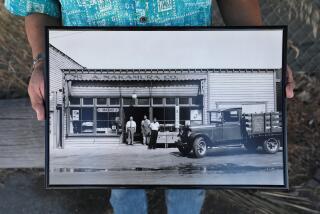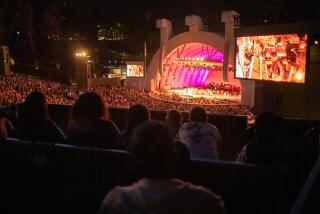S.F. Lanes Won’t Be Spared
- Share via
SAN FRANCISCO — Each afternoon, Howard Johnson packs his trusty 16-pound bowling ball and walks a few short blocks to the heart of this city’s dwindling Japantown, where he takes part in a neighborhood ritual.
At his beloved Japantown Bowl, the retired hospital worker enters a deafening world of ball-throwing waiters, teenagers, car repairmen, hotel doormen and Japanese American families--along with members of the city’s oldest lesbian bowling league--who all consider the aging lanes a welcoming oasis.
But after 24 years, the pins are about to stop falling at Japantown Bowl, one of the last places left to play the game in San Francisco. Saying that the lanes no longer make money, the owners are closing the center this month and replacing it with a commercial-retail complex.
Here in America’s most expensive city, many residents bemoan the loss as the latest sign that San Francisco is abandoning its blue-collar roots and surrendering its soul to the growing dot-com culture.
“It’s a hurtin’ thing,” said Johnson, who is 68 and competes in five leagues at the center. “This ain’t just no average bowling alley. It’s a real outlet for people like me. And it’s a damned shame they’re going to take this place away from us.”
Angry bowlers have besieged the mayor’s office, written letters to local newspapers and crowded into a public hearing insisting that they don’t want the 40,000-square-foot building to fall prey to any Internet start-ups.
A group of neighborhood nisei, or second-generation Japanese Americans, has offered $6.7 million to keep the lanes open. But so far they and alley owners remain as far apart as a 7-10 split.
Meanwhile, the city has launched a study of how the loss of the Japantown Bowl would affect San Francisco, and officials have offered incentives to any buyer promising to preserve the lanes.
“Are these alleys going to become another windowless dot-com complex, or can they remain a place where teens and seniors can pay a dollar a game?” asked Supervisor Mabel Teng. “To let these alleys close is failing to serve our common residents. And that’s the worst mistake a city can make.”
That mistake, Johnson said, has sent 35 displaced Japantown Bowl leagues scrambling to find a new home at one of the city’s two remaining alleys or in the far-flung suburbs.
Half the center’s 2,000 regulars may be forced to quit the sport, he said, especially retirees who cannot drive to other lanes.
Bowlers such as Jim Cheslin worry that the vociferous alley antics of gays and lesbians won’t be accepted anywhere else. “This place is gay-friendly,” he said. “You can hug people and nobody cares. We’ll be a little cautious at other alleys.”
Worst of all, said alley regular Chris Hirano, the closing of the city’s biggest bowling alley deals a crushing blow to the surrounding Japantown community, located in the heart of San Francisco far from the fashionable areas of Russian Hill and North Beach, off the beaten tourist track.
Hirano said the sale by the center’s Japanese owners will accelerate the decline of the nation’s oldest Japantown, which has shrunk from 34 blocks after World War II to eight today.
“These lanes,” he said, “are the soul of the entire neighborhood.”
If it is closed, Japantown Bowl will join the ranks of the Baghdad, Lincoln and Castle, some of the dozen local alleys shut down in recent years.
Richard “Shorty” Green doesn’t want to see that happen.
Each Monday night, his team, Puff Daddy and the Family, battles a collection of competitors that he says can be found nowhere else.
“Look around,” he said. “There’s blacks, whites, Asians. Gays and lesbians. Young kids and old geezers. And we all get along. We have fun. You don’t see that much in San Francisco anymore.”
Since opening in 1976, the center has adopted the city’s bowling fanatics as its own.
The lanes feature 24-hour weekend bowling, attracting a host of late-night loners. To accommodate late-working restaurant employees, Japantown Bowl’s 40 lanes remain open until 2 a.m. one night a week--an hour longer than usual--so waiters and dishwashers have a place to go after work.
The center’s pet project involves its youth bowlers, who day manager Darrell Herbert says would spend more time on the streets without the afternoon leagues.
Herbert, who volunteers as youth director, leaned over his counter to hug a line of gangly teenagers who showed up one afternoon, talking about league averages and delivery follow-throughs.
“We’ve turned around some tough kids,” he said. “It’s the reason I’ve stayed here 22 years.”
To keep youths coming back, the management has held down prices for teenagers and senior league bowlers. Seizing on the popularity of professional wrestling, managers introduced “Cyber-Smackdown Thursdays.’ That’s when youths watch wrestling as they bowl and can win tickets to matches.
After the advent of electronic scoring, Japantown Bowl began classes to teach young bowlers the old way--using pencil and paper--to keep track of the game.
Things weren’t always so welcoming for gay and lesbians.
Herbert recalled his shock at seeing the first gay leagues arrive in 1979. “I couldn’t look when somebody rolled a strike,” he said. “I wasn’t used to such affection between men. Or women.”
He got used to it--and eventually competed in several gay leagues.
Seven gay and lesbian leagues now meet each week at the 20 lanes on the center’s secluded second floor--relishing the sense of privacy that many gay bowlers say allows them to be themselves.
Lesbian league President Cathy Patterson has put other alleys on notice that gay bowlers won’t change their style when they relocate.
“When I’m scouting lanes, I tell managers, ‘If you’ve got a problem with gays, say so now,’ ” she said. “We are who we are. And if we can’t be us, we won’t bowl there.”
Patterson watched a bowler roll a strike and jump into the arms of a teammate. “We’re gonna miss this place,” she said. “There’s only one Japantown Bowl.”
A Shrinking Neighborhood
For Hirano, his neighborhood lanes have always been the coolest place in town. He rolled his first strike there, played his first video game there, took his first date there too.
“Twenty years later,” said Hirano, community development director for Japantown’s cultural center, “I still get the same feeling here.”
But like its bowling alley, Japantown is in trouble.
Although the shrinking community continues to be a tourist draw, few Japanese families live there anymore. Many shops are now owned by Koreans, as young Japanese abandon family businesses.
Allen Okamoto worries that even worse times are ahead for what was once the nation’s largest Japantown.
The average age of the area’s nisei is now 80, he said. And 60% of the city’s Japanese Americans marry outside their ethnicity, further diluting the culture.
Residents are drawing the line with Japantown Bowl.
“We don’t want to lose these lanes,” said Okamoto, president of the Japanese Cultural and Community Center of Northern California, which helped broker the deal to buy the lanes. “The more land we lose, the more of our identity we lose as well.”
Activists were baffled by the rejection of their offer. Okamoto said: “The owners told us bowling was a dying sport.”
Colin Gomez, general manager of Kintetsu Enterprises Co. of America, said the alleys have not increased profits in a decade.
“It was a painful decision to close these lanes,” he said. “But we no longer saw this as a business we could maintain and keep something everybody could be proud of.”
Mark Miller, editor of the Bowlers Encyclopedia Record Book, said the sale mirrors a national trend that has seen the number of bowling centers fall from 11,000 in 1962 to just 6,400.
“Most of those are mom-and-pop places in the inner city,” he said. “Those that stay open do so for the camaraderie of bowling. When owners start to think in terms of ‘What can I get per square foot for the building?’ the battle is over. Bowling can’t compete.”
Supervisor Teng would like to see the city manage the lanes. “We run golf courses, baseball courts, soccer fields and swimming pools,” she said. “Is running a bowling alley any different?”
Johnson knows one thing: He’s going to miss the old center’s comforting soundtrack, its deafening explosion of lumbering polyurethane spheres blasting into all those pins.
He’ll miss seeing the swishy, high-haired waitresses deliver draft beer and watching alley staffers spray antiseptic into sweaty rental shoes, from a kiddie size 1 to Bigfoot 15s.
Rolling on Lane 17 on a recent night, he grinned as he barely converted a baby-split.
“I just got lucky,” he said, pausing to glance at the bevy of fellow bowlers who will soon roll their last games at Japantown Bowl.
Then he added, almost to himself: “But my luck’s running out.”
More to Read
Go beyond the scoreboard
Get the latest on L.A.'s teams in the daily Sports Report newsletter.
You may occasionally receive promotional content from the Los Angeles Times.











